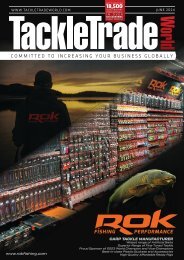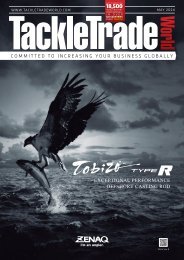Create successful ePaper yourself
Turn your PDF publications into a flip-book with our unique Google optimized e-Paper software.
DBW...<br />
SCANDINAVIA<br />
D O I N G B U S I N E S S W I T H . . .<br />
SCANDINAVIA<br />
With rivers and lakes in abundance, not to mention an extensive coastline,<br />
Scandinavia has a proud tradition of recreational fishing, both as a top<br />
destination for the sport and as the innovator of key products via major brands.<br />
For the purposes of<br />
this article, we will<br />
consider Scandinavia as<br />
encompassing Denmark,<br />
Norway and Sweden,<br />
although there are schools<br />
of thought which will<br />
add in both Finland and<br />
Iceland – usually these are covered by the<br />
term ‘Nordic’ instead.<br />
The total area of these three nations<br />
is about 358,325 square miles, making it<br />
bigger than any other single European<br />
country, with more than 21 million<br />
inhabitants, although the population<br />
density of this region is very low, at less<br />
than 60 people per square mile.<br />
Undoubtedly, the largest country is<br />
Sweden, which is also the most populated,<br />
with more than 10 million inhabitants,<br />
while Norway and Denmark each have less<br />
than six million.<br />
There are multiple languages spoken<br />
throughout Scandinavia including<br />
Norwegian, Danish and Swedish, while<br />
Icelandic, Finnish and Sami languages are<br />
also in evidence.<br />
Scandinavia has always enjoyed a<br />
reputation for a good quality of life –<br />
indeed Denmark is ranked at number four<br />
and Norway at number nine in the world<br />
table of best countries to live in.<br />
While the 2023 <strong>World</strong> Happiness<br />
Report cites Denmark in second spot, with<br />
Sweden sixth and Norway seventh, based<br />
on factors including low income inequality,<br />
health care and education.<br />
NATURAL RESOURCES<br />
The early industrialisation of the Nordic<br />
countries was based on key natural<br />
resources. Norway and Sweden had large<br />
forests so timber, pulp and paper were<br />
crucial commodities – indeed Sweden is<br />
the home of furniture giant IKEA.<br />
It also has significant iron ore reserves,<br />
which brought wealth to the country even<br />
before modern industrialisation. Norway’s<br />
most important industries have been<br />
forestry, fishing and hydropower while, in<br />
later years, vast oil and gas deposits in the<br />
28 www.tackletradeworld.com

















